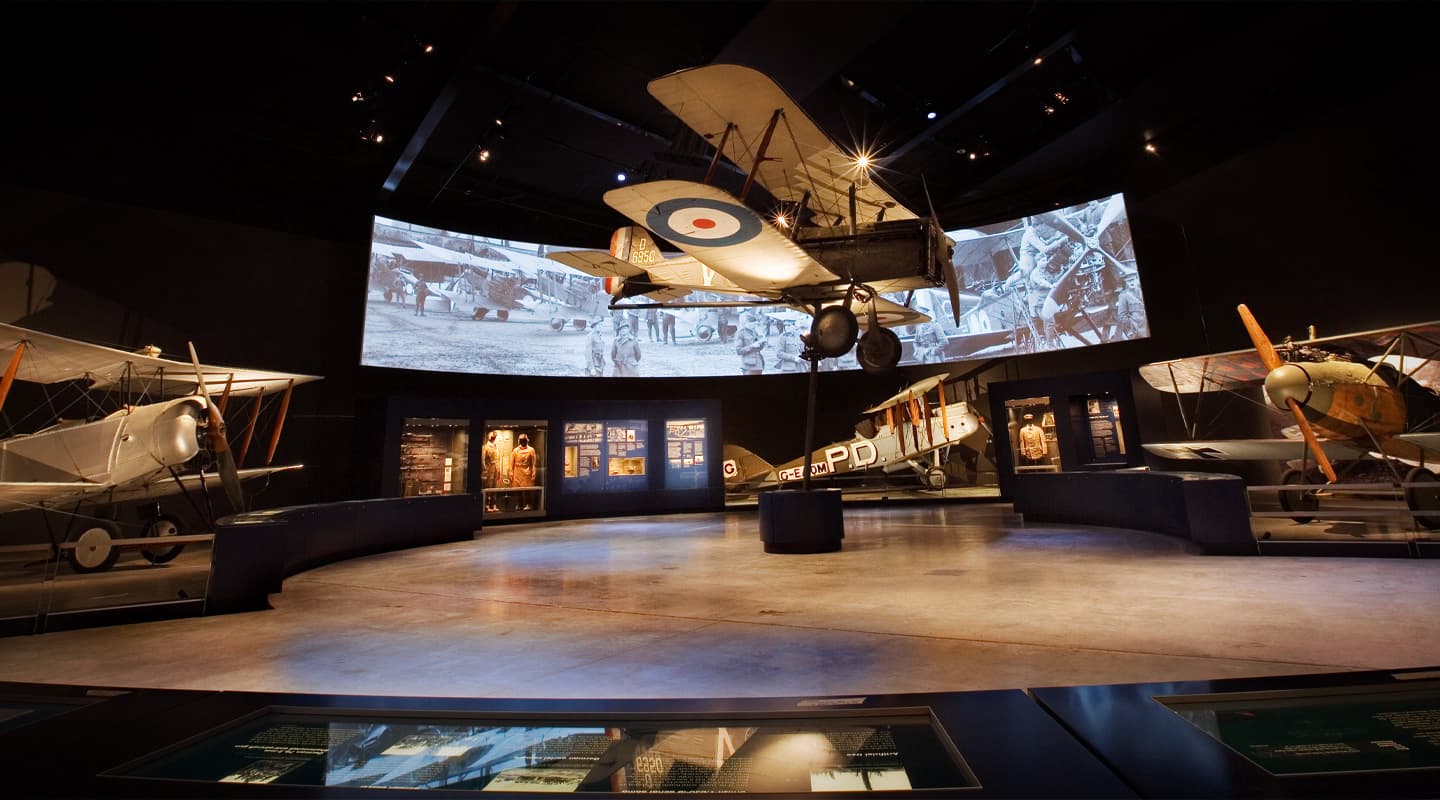
Over the Front
Some audiovisual know-how along with Peter Jackson’s passion for WWI aircraft has given the Australian War Memorial a winner of an exhibit.
Text:/ Tim Stackpool
Photos:/ John Gollings
With Australia’s World War One aviation heroics now almost the stuff of folklore, the Australian War Memorial (AWM) embarked on a major exhibit, recording and reproducing the very-real exploits of Australian pilots in the skies over the Western Front in France and in the Middle East. Most times, the young Aussies fought airborne battles in flimsy machines of wood, canvas and wire. In a collaborative trans-Tasman effort, Over The Front brings artefacts and visuals to visitors, ensuring the gallant deeds of our early pilots are recollected and recognised.
Bruce Brown, Project Manager with Mental Media in Sydney, oversaw the AV installation which included consulting on the hardware design, specification, and documentation in collaboration with Alex Smythe, AV Manager at the Memorial. The exhibit features five aircraft – three Allied types and two rare German fighter planes – along with other collection items including the left boot of The Red Baron, Baron von Richthofen. Aside from the AV, the aircraft and collection objects are displayed in an exhibition designed by Freeman Ryan Design and include a 21m x 3.5m curved projection screen.
BLANK CANVAS?
Situated in the Anzac hall, the virtual blank canvas did represent a number of challenges. “The exhibition uses approximately one third of the hall and is open to the other two thirds and although it is important to immerse the audience in the sound experience it is also important not to cause too much disruption to the rest of the exhibitions in the hall,” Bruce Brown said. “This was achieved by careful choice and placement of the components and by expert system tuning undertaken by Tony Russo from Technical Audio Group.” The sound was produced in the 7.1 Dolby Digital Cinema surround system and plays an important role in the interpretation of the production.
For Tony Russo, natural acoustic ‘bounce’ became the enemy. “I needed to overcome the vast areas of hard reflective surfaces such as the polished concrete floor and glass typical of museums and galleries. My experience has taught me these spaces are like sacred sites to staff; don’t even mention adding acoustic treatment to surfaces, just deal with it,” Tony said. “We worked with our local dealer Darrin Russell from Elite Sound and Lighting and Glen Harrison from HME Engineering, who was responsible for all the tricky steel fabrication, and together we came up with a turnkey solution.”
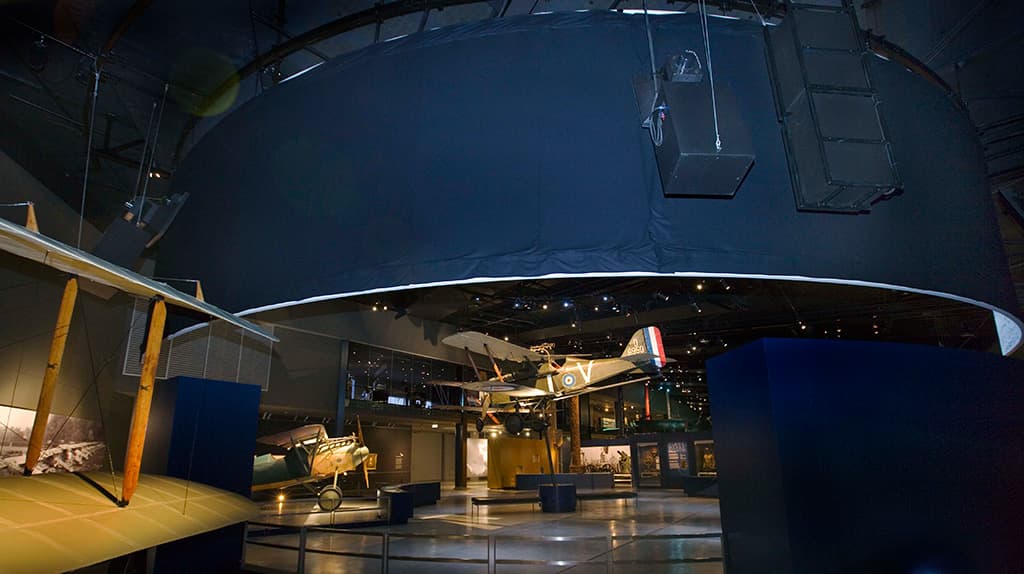
Photo: Tony Russo • All Sortied: Martin Audio cinema speakers behind the acoustically transparent projection screen.
CINEMA SOUND
A Martin Audio Screen system is suspended behind the curved screen in a left-centre-right configuration. This comprises 3 x Martin Audio Screen 5 THX-approved cinema active three-way systems, with dual 15-inch low frequency drivers, a large-format mid/high horn containing six-inch horn-loaded midrange, and a one-inch compression driver.
The surround speakers (being 2 x Martin Audio Screen 1a high-powered 18-inch sub-bass units, to THX spec) are suspended far left and right of the space with a overhead dead centre effect speaker. Once the seven channels leave the surround decoder they’re processed via the QSC Audio Basis system which handles all the audio processing as well as load monitoring, fault reporting, remote IP access and amp control. Klotz cable was used throughout.
Ultimately Russo went for realism, saying “It’s mostly about putting sound exactly where you want it and nowhere else. The choice of speakers gave me genuine pattern control down to 300Hz which helped me on the way to conquering the space. The Screen 5 from Martin Audio is a THX Hollywood cinema-size cabinet and stands well over two metres high. The large format mid/high horn gives hi-fi-sounding results but at concert levels. I want the people to feel like they were in the cockpit during the air battles, such that the fly-bys really felt like a plane had just buzzed through the memorial and over their heads. It’s a fine line between too much volume and effect, and making it realistic. It’s no different to riding a major theatre show – a quarter of a dB here or there can make all the difference.”
ALERT BUT NOT ALARMED
Beyond the audio install, Russo also had to consider the ongoing maintenance of the system. “This exhibit really will be running non-stop, so reliability is everything and the key to reliability is fault monitoring,” he said. “When something in the system does fault – such as an open circuit driver, faults on the speaker line, or an intermittent amp fan – then the operators need to be instantly alerted of the exact nature of the fault.”
To manage this, the system can send alert messages via email or SMS and the technical team then remotely log onto the system to check everything and pinpoint exactly where the problem is. Tony Russo again: “Remember, these exhibits run automatically every hour without operators so you don’t have the benefit of tech staff picking up problems, and I know the 81-year-old lady from Queensland on holidays doesn’t tell the staff that there should have been more top end above 8k on the left stack.”
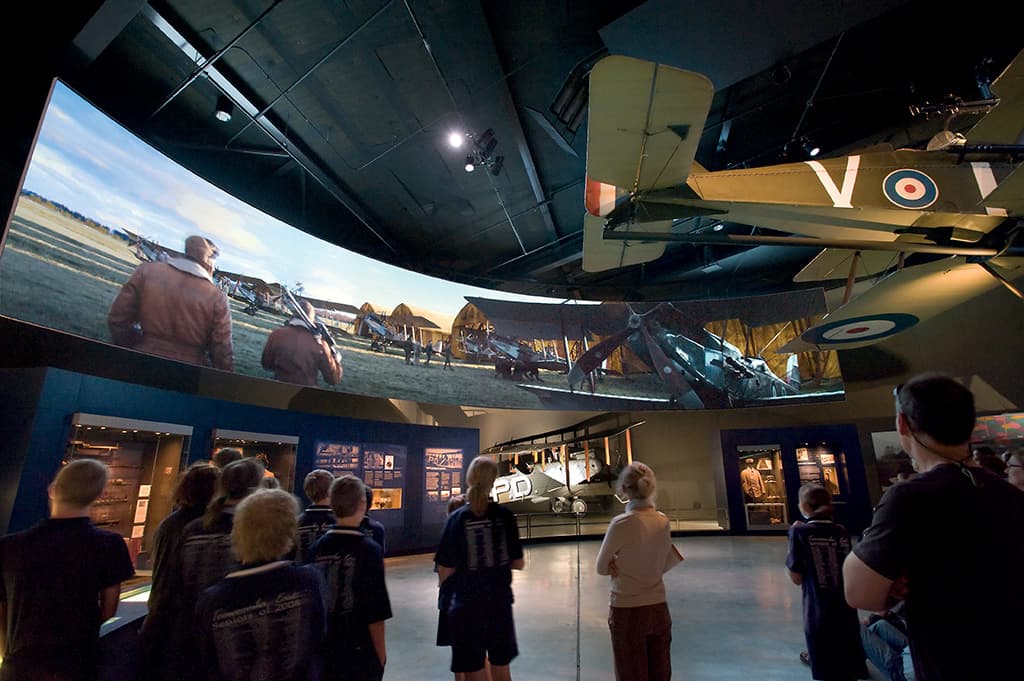
PROJECTION RIG
Turning to the visuals, the projection rig, required to deliver content produced at 6000 pixels wide by 1000 pixels high, was installed by the AWM AV staff with the screen and rigging points fine-tuned by Glen Harris of Harris Movement Technology. The visual content was produced by none other than New Zealand filmmaker Peter Jackson – better known for his epic elf wars. He did however, utilise his chairperson position with the 1914-18 Aviation Heritage Trust to bring visitors of the AWM a bird’s-eye view of what it was like to fly a fighter plane. The aircraft used in the film were sourced from the Aviation Heritage Trust by Jackson himself. These flyable replicas were used in conjunction with scale models and clever computer animation. Working with his production company, Wingnut Film Production, Jackson has devised an awe-inspiring piece which makes the most of the wrap-around screen. With visual effects by Weta Digital, the installation provides the audience with remarkable insight and is enhanced by the audiovisual system.
The original footage was shot on three Red 4K cameras mounted on various reproduction aircraft to capture the action footage. The vision was then stitched together in post production by Weta Studios. The image is seamless. At 3.5m high, the screen curves around 110 degrees at an 11m radius and is bright enough to overcome ambient light levels.
Furthermore, the projection shoots around an airplane suspended in the middle of the space. According to Bruce Brown, this represented the most difficult issue of the project. “The space was empty and as the positions of the screen and the plane were ‘planned’ there were lots of things that could go wrong,” he said. “Using the projector’s geometry correction and requesting small adjustments to the mounting of the plane, we determined that we could achieve it with 50mm to spare – a very small degree of error.”
In order to achieve this, the team installed the screen and projector rigging bar prior to anything else, making the positioning accurate to within a few millimetres. Further accuracy was ensured by marking out the exhibition on the floor, including all exhibition showcases, plinths, planes and other items. “All measurements and the rigging points for the screen and projectors were then based on the marked out exhibition,” Brown said. Projection geometry perfection was finally achieved when Mental Media requested an additional five degrees tilt for the SE5a fighter plane mounted in the middle of the exhibition.
SOMME KINDA CONTROL
The entire presentation is controlled by a Medialon system installed and programmed by Interactive Controls as part of the AWM’s overall multimedia control system. The Medialon system schedules the Over the Front production as well as the other productions in the rest of the Anzac Hall in a linear timeline to prevent audio clashes across the space. The production itself is delivered by the Dataton Watchout application running on four computers. The production was programmed via the Watchout system, which undertakes edge blending as well as, according to Brown, a highly sophisticated and malleable geometry correction facility to enable accurate edge blending and correction on the curved screen.
The image is delivered to the projectors via Gefen DVI fibre optic baluns. Projectors are monitored and controlled over Cat-5. Audio files are also delivered from one of the Watchout computers to the surround sound decoder in the equipment rack. Lighting control is from the Medialon system via a pre-installed Jands Vista console and Dynalite dimmers.
EQUIPMENT LIST
- Custom-built 3.5m x 21m curved screen frame covered with matte white standard perforated cinema screen material
- Custom-built projector rigging bar 4.5m radius
- 4 x Chief RPA Mounts
- 4 x Gefen DVI 1000HD fibre TX/RX
- 4 x Projectiondesign F32 1080 projectors
- 4 x AWM standard display computers c/w Dataton Watchout keys & networking
- 3 x Martin Audio Screen 5
- 2 x Martin Audio Screen 1A
- 9 x Martin Audio Effect 5
- 2 x QSC Audio Basis 922az
- 5 x QSC Audio PL230
- 2 x QSC Audio PL236
- 1 x Denon DNA7100 surround sound encoder
WETA APPETITE
In dealing with a world recognised motion picture company for the visuals, Mental Media spent some time convincing Weta Studios that their delivery platform presented Weta’s production at the quality they expected. “Weta were unfamiliar with the Dataton Watchout system and the Projectiondesign projectors,” Bruce Brown said. “We sent Dean Stevenson from Interactive Controls to Weta in Wellington with an AWM presentation-standard computer and Amber Technology (the Projectiondesign distributor) arranged for the supply of a projector so a single screen could be viewed in Weta’s preview theatre. This also allowed them to optimise the data compression codec to their images. However, questions remained about the edge blending and geometry correction and it wasn’t until test files were run on the installed system that they were convinced the solution would meet, and in fact exceed their expectations,” he added.
Another challenge involved ensuring the hardware installation had a very low visual impact. Visitors to the AWM can view the gallery through floor-to-ceiling windows from the Landing Place Café located on the mezzanine level of Anzac Hall. It was important to ensure the projectors were tucked up as close as possible to the roof to avoid interrupting sightlines to the exhibition. This was achieved by utilising the full 110% vertical lens offset available from the projectors and setting them at a distance from the screen that placed them as high as possible under the sloping ceiling of the hall.
MISSION ACCOMPLISHED
Ultimately, the project was required to satisfy four principal criteria. In essence, the system had to be compatible with the existing multimedia hardware and systems at the Australian War Memorial, and be easily maintained. Additionally, the images and sound had to meet the exacting standards of Peter Jackson and Weta Studios. The hardware installation was to remain discreet, with the exhibition being about the content and design created by Freeman Ryan Design, not about the technology. And finally, the multimedia had to be consistent with the aims of the high standards set by the Directors of the Australian War Memorial.
For Russo, a personal challenge was being objective about the subjective elements of the audio. “Even after days of objective computer tuning and testing, matching what’s happening on screen from the film involves countless more hours of subjective listening,” he said. “Do you add a bit more 1k, so when a wing breaks off mid-flight it sounds realistic; or 4k when the gunman is firing his rounds from the cockpit? It’s a fine balance. It’s no longer about nice flat responses on the computer screen.”
With a nine-month turn-around from concept to completion, it seems the display is a high-flying success, as Bruce Brown summed up: “It looks good, it sounds good, everything works as expected, the client is happy – what more could you ask for?
A video of the installation of the exhibition, commencing with the mark-out.


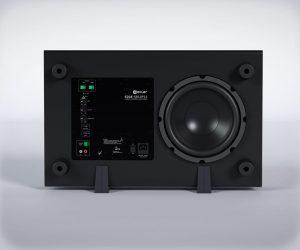





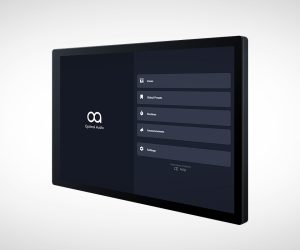

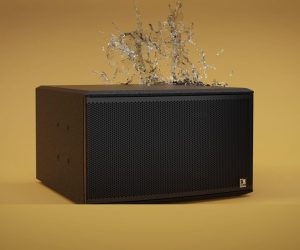




RESPONSES